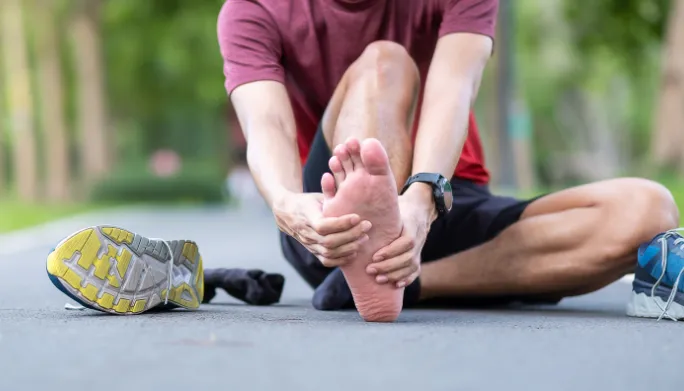Plantar Fasciitis in Connecticut

Let’s cut straight to it—if you’re waking up with sharp, stabbing heel pain every morning, there’s a good chance you’re dealing with plantar fasciitis. It’s one of the most common causes of heel pain, and we see it constantly at Carlson Procare, especially among people here in Connecticut who are on their feet all day, runners, and active professionals trying to stay mobile.
But here’s the thing: plantar fasciitis doesn’t just “go away” by ignoring it. It lingers. And the longer you let it go untreated, the more it changes the way you walk, stand, and live your daily life. If you’re feeling frustrated, don’t worry—you’re in the right place.
This guide breaks down what plantar fasciitis actually is, how to recognize it, what causes it, and most importantly—how to treat it effectively and prevent it from coming back.
Understanding Plantar Fasciitis: What’s Actually Going On?
Your foot has a thick band of tissue called the plantar fascia that runs from your heel to the ball of your foot. Its job is to support your arch and absorb shock with every step. Now, imagine what happens when that tissue gets overstretched or overworked: tiny tears start forming. Inflammation sets in. And that’s where the stabbing pain begins—especially during your first few steps in the morning or after sitting for a long time.
Plantar fasciitis isn’t a small issue. It affects how your entire foot functions. And because your feet are the foundation of every movement, it can trigger a chain reaction of discomfort through your ankles, knees, hips, and even lower back.
Common Causes of Plantar Fasciitis in Connecticut
If you’re wondering why this is happening to you, you’re not alone. Most people don’t realize how many everyday habits can lead to this kind of heel pain. Let’s dig into the most common culprits:
Overuse and Repetitive Stress
Whether it’s running on pavement, working a job that keeps you on your feet for hours, or ramping up your workout intensity too quickly—overuse is a leading trigger. That constant pressure causes strain and microtrauma to the fascia.
Poor Footwear
Shoes with little to no arch support or cushioning (looking at you, flip-flops and worn-out sneakers) force the plantar fascia to absorb more impact than it should. This is especially harmful on hard surfaces.
Flat Feet or High Arches
Both extremes can place abnormal tension on the fascia. Flat feet lack the structural support, and high arches don’t absorb shock well—either way, it leads to strain.
Tight Muscles
Tight calves and Achilles tendons pull on the heel bone, which increases stress on the plantar fascia. This is why flexibility matters more than people think.
Weight Gain
Extra body weight means more pressure on your feet with every step. That added load directly affects the fascia and increases risk of inflammation.
Aging and Lifestyle
Plantar fasciitis tends to show up more in people over 40. Combine that with reduced physical activity, stiff joints, or sedentary habits, and your fascia is working harder than it should.
Diagnosing Plantar Fasciitis: How to Know It’s Not Just “Foot Soreness”
The pain from plantar fasciitis has a few telltale signs—and recognizing them early is key to getting ahead of the problem.
Self-Check Questions
-
Do you feel a sharp pain in your heel when you take your first steps in the morning?
-
Does the pain ease slightly after moving but return after standing or walking for long periods?
-
Are you compensating by shifting your weight to the outer edge of your foot or walking differently?
If you answered yes to any of those, chances are high that plantar fasciitis is the cause. Still, it’s important to rule out other conditions like heel spurs, nerve compression, or stress fractures.
When to Get It Evaluated
If the pain persists for more than a week or worsens over time, it’s time to seek a professional evaluation. At Carlson Procare, we take a hands-on approach—combining functional movement screens, gait analysis, and clinical assessments to pinpoint the root cause.
Sometimes, imaging like X-rays or ultrasounds may be used to rule out other heel conditions, but in most cases, a detailed physical exam is enough to confirm plantar fasciitis.
Treatment Options: How to Actually Get Rid of Plantar Fasciitis in Connecticut
Good news: most cases of plantar fasciitis can be treated without surgery or invasive procedures. The key is getting a personalized plan—and sticking to it.
Home Remedies That Help
-
Rest and Ice: Especially after periods of standing or exercise. Ice helps reduce inflammation.
-
Stretching: Calf stretches and plantar fascia stretches can relieve tension. Use a towel or band to gently stretch your foot before getting out of bed.
-
Footwear Changes: Ditch the unsupportive shoes. Invest in footwear with strong arch support and cushioned soles. Orthotics can also help.
Physical Therapy at Carlson Procare
This is where we step in. Our physical therapy programs are built around improving foot mechanics, relieving pain, and restoring mobility. That includes:
-
Manual therapy to release tight fascia and muscles
-
Targeted stretching and strengthening
-
Dry needling and instrument-assisted soft tissue mobilization when appropriate
-
Balance and gait retraining to prevent re-injury
Advanced Medical Treatments
If conservative care isn’t cutting it, we can guide you through more advanced options:
-
Night splints to keep the fascia stretched overnight
-
Custom orthotic insoles
-
Cortisone injections for short-term relief (if inflammation is severe)
-
Shockwave therapy or platelet-rich plasma (PRP) for stubborn cases
We’re not big on one-size-fits-all care. We treat the individual, not just the foot pain.
Preventing Plantar Fasciitis in Connecticut: Stay Ahead of the Pain
Once you’ve had plantar fasciitis, you’re more likely to get it again—unless you make a few changes. Prevention is part of every plan we build at Carlson Procare.
Stretching and Mobility Work
Add calf and Achilles stretches to your daily routine. Foam rolling and mobility drills go a long way in keeping your fascia healthy and resilient.
Proper Footwear
Shoes matter more than most people think. Make sure yours match your activity level. If you’re unsure, we’ll help you figure out what works best for your foot structure and daily demands.
Gradual Activity Progression
Going from zero to 100 in workouts or activities is one of the fastest ways to trigger plantar issues. Ease into new routines, especially if you’re returning after time off.
Strength Training
It’s not just about the foot. Strengthening your hips, glutes, and core helps with alignment and load distribution—taking pressure off your feet.
Your Heel Pain Has a Solution—And It Starts Here in Connecticut
You don’t have to live with that first-step pain every morning. At Carlson Procare, we’ve helped hundreds of clients across Connecticut overcome plantar fasciitis and return to pain-free movement. Whether you’re a nurse on your feet all day, a weekend warrior, or just someone who’s tired of limping through life, we’re here to guide your recovery—step by step.
We’re not here to just patch up symptoms. We identify the root, build a treatment plan around your goals, and make sure you’re equipped to stay pain-free long after your first visit.
Heel pain doesn’t need to be your “new normal.” Let’s fix it—together. Schedule your consultation with Carlson Procare today.


